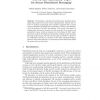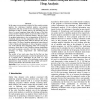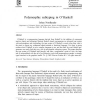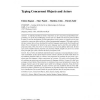111
click to vote
IFIP
2010
Springer
14 years 7 months ago
2010
Springer
Abstract. We introduce a calculus with mobile names, distributed principals and primitives for secure remote communication, without any reference to explicit cryptography. The calc...
127
Voted
CORR
2011
Springer
14 years 7 months ago
2011
Springer
In this paper, we present type systems for flow-sensitive pointer analysis, live stack-heap (variables) analysis, and program optimization. The type system for live stack-heap ana...
102
click to vote
TACAS
2010
Springer
14 years 10 months ago
2010
Springer
Abstract. Intermediate languages are a paradigm to separate concerns in software verification systems when bridging the gap between programming languages and the logics understood ...
123
Voted
WOLLIC
2010
Springer
14 years 10 months ago
2010
Springer
Abstract. The λ-calculus with de Bruijn indices, called λdB, assembles each α-class of λ-terms into a unique term, using indices instead of variable names. Intersection types p...
144
Voted
TOPLAS
2010
14 years 10 months ago
2010
program constraints are defined over a program’s abstract syntax tree. The JAVACOP compiler automatically enforces these constraints on programs during compilation. The JAVACOP ...
99
Voted
OOPSLA
2010
Springer
14 years 11 months ago
2010
Springer
We introduce a type system based on intervals, objects representing the time in which a block of code will execute. The type system can verify time-based properties such as when a...
101
click to vote
SCP
2002
15 years 2 days ago
2002
O'Haskell is a programming language derived from Haskell by the addition of concurrent reactive objects and subtyping. Because Haskell already encompasses an advanced type sy...
97
Voted
LOBJET
2000
15 years 6 days ago
2000
ABSTRACT. As informal methods do little to help their use for concurrent and distributed programming, one of the most challenging current tasks is to build tools based on formal me...
133
Voted
ENTCS
2002
15 years 7 days ago
2002
A program analysis is compositional when the analysis result for a particular program fragment is obtained solely from the results for its immediate subfragments via some composit...
110
click to vote
ENTCS
2000
15 years 7 days ago
2000
We lift Cardelli, Ghelli and Gordon's secrecy group creation operator [1] to a relative of the spicalculus that supports symmetric key cryptography, and show a natural extens...




